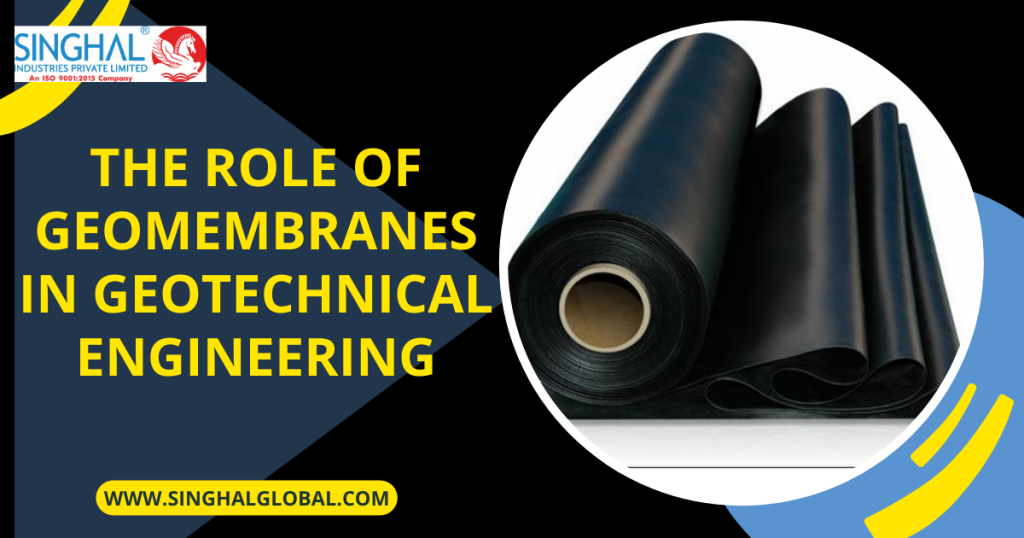The primary use of the HDPE Geomembrane sheet is to enhance the sustainability and performance of geotechnical engineering projects. It is mainly used in construction to protect the landscape and environment.
The use of these sheets has transformed the engineering industry, making it an indispensable material for construction. Perfectly engineered, these sheets have a wide variety of applications.
If you want to know more about the utility and performance of polypropylene geomembrane sheets, you are in the right place. This article explores the features and functionality of these membranes and the significant effect it has in geotechnical engineering.
A Brief Overview of Geomembranes
At the first instant, the word geomembrane sounds more like a terminology used in the medical realm. However, it has nothing to do with it, and it does not signify an erroneous medical experiment.
These membranes are synthetic liners usually used as a barrier that prevents the migration of fluid or controls it. It has some fascinating and varied applications, which include but are not limited to manmade structures, projects, or systems.
Usually, you will get these membrane liners in continuous, thin polymeric sheets with the geomembrane sheet suppliers. The utility of these membrane liners in geotechnical engineering seems to be endless, especially those that are made by blending geotextiles with elastomer, asphalt, or polymer sprays.
These specially designed geomembrane sheets are also used widely in industrial settings for different purposes and spheres. This includes transportation, oil and gas, hydraulic, environmental, and waste industries.
The most common HDPE geomembrane sheet is the one that you get in continuous sheets made from polymer.
These sheets are pretty long, but the good thing about them is that when you need a larger geomembrane than what is usually available to use in a specific project, you can melt the edges of two sheets thermally or by using specific chemicals and join them together. This will not affect the strength or durability of the material adversely.
Typically, the size of these polypropylene geomembrane sheets is fully customizable. This means that you can use them for the small fish pond in your backyard or projects as big as a football field. Everything depends entirely on your needs.
The Common Uses
One of the most widespread uses of the geomembrane sheets is as a liner for different projects and objects, such as:
- Reserve water
- Potable water
- Fish pond
- Waste liquids or sewage sludge
- Hazardous or radioactive waste liquid
- Agriculture industry
- Canals for waste conveyance
- All types of primary, secondary, and tertiary solid-waste landfills
- Waste piles
- Emergency spillways
- Tunnels for waterproofing and
- Pipelines.
In addition, the geomembrane sheet suppliers also supply these membranes to other facilities for other purposes and applications. One such is in the nuclear facilities that want to ensure a safe shutdown.
It is also used in transportation trucks in order to contain the liquids while carrying. Talking about liquids, these membranes are also used in the ocean to contain and transfer potable water.
Another common usage of polypropylene geomembrane sheets that you must have noticed is under the highways. This is usually done to prevent pollution, corrosion, or damage caused by the deicing salts. It is also used next to highways or underneath to capture spills of hazardous fluid.
The Crucial Roleplay
So, now that you know the different applications and utility of the geomembrane sheets, it is time to take note of their significance in the field of geotechnical engineering.
In simple words, the most significant role played by the geomembranes in geotechnical engineering projects is to prevent the loss of any kind of substance that is not permissible from its selected place. It can be anything. For example, it can be used to prevent soil from erosion or contain wastewater or clean water.
The primary purpose of using these membranes during construction is that they prevent any devastation caused by improperly managed pooling, standing, flowing, or frozen liquid and vapor.
The specific design of these geomembrane sheets and their sustainability and strength allow the use of them for several other projects now that were usually constructed earlier without using these membranes.
The Useful Characteristics
It is due to the HDPE in these geomembrane sheets, which is an acronym for High-Density Polyethylene. HDPE creates an impermeable layer and does not allow liquids and even gases to pass through.
Some other valuable characteristics of these sheets make them so favoured in the geotechnical engineering industry include the following:
- Higher chemical resistance
- Greater durability and
- UV radiation resistance.
Another essential characteristic of HDPE sheets is their higher flexibility. This means that these sheets can be used on objects with irregular surfaces.
No matter where or how it is used, the geomembrane sheets reduce the hazard of leakage significantly. They not only prevent the leakage of water and contaminants but also protect the groundwater and soil underlying the membrane.
Depending on the different characteristics of the geomembrane sheets, its usage may vary. For example, in tunnel or mining constructions, it is necessary to maintain a perfect balance between flexibility and strength. In these specific types of construction sites or utilities where soil settlement or movement is expected, polypropylene geomembrane sheets are used.
This is because the polypropylene material is usually made from a thermoplastic polymer. This specific type of polymer is known for its higher chemical resistance and robustness. Both these characteristics of polymer make these sheets highly functional and durable, even when they are exposed to harsh environments. Most importantly, these specific sheets are ecologically compatible.
Conclusion
In conclusion, the geomembrane sheets play a very crucial role in the field of geotechnical engineering, offering much more than protection or prevention of water leakage. It helps prevent contamination of soil and water, thereby contributing to the preservation of vital natural resources actively.
In the long run, it also saves a considerable amount of money by preventing the need for expensive remediation. It also reduces the cost of projects not requiring frequent replacements due to its high durability. Most importantly, it helps minimize the ecological footprint of different projects.









